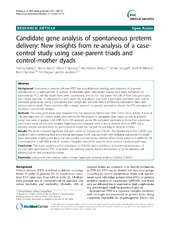| dc.contributor.author | Myking, Solveig | en_US |
| dc.contributor.author | Myhre, Ronny | en_US |
| dc.contributor.author | Gjessing, Håkon K. | en_US |
| dc.contributor.author | Morken, Nils-Halvdan | en_US |
| dc.contributor.author | Sengpiel, Verena | en_US |
| dc.contributor.author | Williams, Scott M. | en_US |
| dc.contributor.author | Ryckman, Kelli K. | en_US |
| dc.contributor.author | Magnus, Per | en_US |
| dc.contributor.author | Jacobsson, Bo | en_US |
| dc.date.accessioned | 2014-11-07T12:55:34Z | |
| dc.date.available | 2014-11-07T12:55:34Z | |
| dc.date.issued | 2011-12-30 | eng |
| dc.identifier.issn | 1471-2350 | |
| dc.identifier.uri | https://hdl.handle.net/1956/8723 | |
| dc.description.abstract | Background: Spontaneous preterm delivery (PTD) has a multifactorial etiology with evidence of a genetic contribution to its pathogenesis. A number of candidate gene case-control studies have been performed on spontaneous PTD, but the results have been inconsistent, and do not fully assess the role of how two genotypes can impact outcome. To elucidate this latter point we re-analyzed data from a previously published case-control candidate gene study, using a case-parent triad design and a hybrid design combining case-parent triads and control-mother dyads. These methods offer a robust approach to genetic association studies for PTD compared to traditional case-control designs. Methods: The study participants were obtained from the Norwegian Mother and Child Cohort Study (MoBa). A total of 196 case triads and 211 control dyads were selected for the analysis. A case-parent triad design as well as a hybrid design was used to analyze 1,326 SNPs from 159 candidate genes. We compared our results to those from a previous case-control study on the same samples. Haplotypes were analyzed using a sliding window of three SNPs and a pathway analysis was performed to gain biological insight into the pathophysiology of preterm delivery. Results: The most consistent significant fetal gene across all analyses was COL5A2. The functionally similar COL5A1 was significant when combining fetal and maternal genotypes. PON1 was significant with analytical approaches for single locus association of fetal genes alone, but was possibly confounded by maternal effects. Focal adhesion (hsa04510), Cell Communication (hsa01430) and ECM receptor interaction (hsa04512) were the most constant significant pathways. Conclusion: This study suggests a fetal association of COL5A2 and a combined fetal-maternal association of COL5A1 with spontaneous PTD. In addition, the pathway analysis implied interactions of genes affecting cell communication and extracellular matrix. | en_US |
| dc.language.iso | eng | eng |
| dc.publisher | BioMed Central | eng |
| dc.rights | Attribution CC BY | eng |
| dc.rights.uri | http://creativecommons.org/licenses/by/2.0 | eng |
| dc.subject | case-parent triad analysis | eng |
| dc.subject | hybrid design | eng |
| dc.subject | haplotype | eng |
| dc.subject | pathway analysis | eng |
| dc.subject | COL5A2 | eng |
| dc.subject | COL5A1 | eng |
| dc.title | Candidate gene analysis of spontaneous preterm delivery: New insights from re-analysis of a case-control study using case-parent triads and control-mother dyads | en_US |
| dc.type | Peer reviewed | |
| dc.type | Journal article | |
| dc.date.updated | 2013-08-23T09:32:09Z | |
| dc.description.version | publishedVersion | en_US |
| dc.rights.holder | Copyright 2011 Myking et al; licensee BioMed Central Ltd | |
| dc.rights.holder | Solveig Myking et al.; licensee BioMed Central Ltd. | |
| dc.source.articlenumber | 174 | |
| dc.identifier.doi | https://doi.org/10.1186/1471-2350-12-174 | |
| dc.identifier.cristin | 899651 | |
| dc.source.journal | BMC Medical Genetics | |
| dc.source.40 | 12 | |

